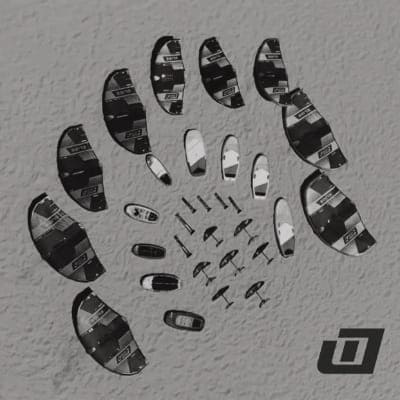Guide types of Wetsuit

Guide types of Wetsuit
When it comes to water sports such as wingfoiling, kitesurfing, windsurfing, and surfing, having the right neoprene suit is essential for maximizing your experience. A neoprene suit not only keeps you warm in cold water but also provides buoyancy and protection against potential abrasions or sunburn. Each sport is unique, and a neoprene suit for kitesurfing is different from one for surfing or diving.
Typically, surfing suits are very elastic to facilitate arm movements, while kitesurfing and windsurfing suits have more reinforcement and windproof elements. They often have a back zip to prevent the formation of the infamous “elephant leg” during falls to keep water from entering at the bottom. Neoprene suits for diving are much thicker or less elastic.
What Is a Wetsuit?
Before delving into the details of how to choose a neoprene suit, it’s important to understand what this type of clothing is and how it works. A neoprene suit is a garment designed to keep the body warm in cold water. It is primarily composed of neoprene, a synthetic rubber material with excellent thermal insulation properties.
How Does Wetsuit Work?
Neoprene works by trapping a thin layer of water between the suit and the skin. This water quickly heats up thanks to body heat, creating a thermal barrier between the body and the cold water. Additionally, neoprene also provides buoyancy, making floating and moving in the water easier.
Types of Wetsuit
There are different types of neoprene suits, each designed to suit various conditions and water activities. The most common types include:
– Full Neoprene Suit: Also known as a one-piece suit, this type of suit covers the entire body, from ankles to wrists. It is ideal for cold waters and provides maximum thermal insulation.
– Shorty: A shorty is a neoprene suit with short sleeves and short legs. It is perfect for warmer waters or water activities that require more freedom of movement.
Thickness
The thickness of the neoprene is another important factor to consider when choosing a neoprene suit. The appropriate thickness depends on the water temperature and your personal preferences (the type and quality of the neoprene also matter apart from thickness). Thicker neoprene provides better thermal insulation in cold waters but may be less flexible. Conversely, thinner neoprene is more suitable for warmer waters and offers greater flexibility. Below is a general guide to recommended thicknesses for different water temperatures:
– Water Temperature (°C) Thickness of the Suit (mm)
– 5°C or less: 6mm – 5mm, hood, boots, and gloves
– 6°C to 8°C: 5mm – hood, boots, and gloves
– 9°C to 12°C: 5mm – 4mm, hood and boots
– 13°C to 14°C: 4mm – 3mm, and boots (optional)
– 15°C to 18°C: 3mm – 2mm, long or short sleeves
– 19°C to 23°C: Neoprene top or shorty
– 24°C to 26°C: Swimsuit / bikini
Remember that these are general recommendations, and some individuals may feel more comfortable with a different thickness.
Choosing the Right Size
Proper fit is crucial to ensure that your neoprene suit provides maximum comfort and performance in the water. An excessively large suit will allow water to enter and exit easily, reducing its ability to keep you warm. On the other hand, a suit that is too tight can restrict movement and hinder breathing.
Here are the steps to choose the right size for your wetsuit:
1. Measure your height and weight.
Most neoprene suit manufacturers provide a size chart based on the user’s height and weight. Take these measurements and use them as a starting point to select the right size.
2. Consider your body type and shape.
In addition to height and weight, you should also consider your body type and shape when choosing the size of your neoprene suit. Some people may have longer arms or legs or shorter torsos, so it’s important to try on different sizes and styles to find the perfect fit.
3. Try on the suit before buying.
It’s always recommended to try on the wetsuit before making a purchase to ensure it fits properly. Pay attention to overall comfort, especially in
the shoulders, armpits, and groin areas. You should also be able to move freely and perform movements as if you were in the water.
A properly sized and fitted wetsuit should feel snug but not restrictive. It should allow you to move freely and feel comfortable in the water. A neoprene suit should be snug and not have visible wrinkles. When dry, it’s common for it to feel a bit tight, but this sensation disappears once the suit gets wet.
Types of Closures
The closure of a wetsuit is another important aspect to consider, as it affects both comfort and performance. There are different types of closures, each with its own advantages and disadvantages. Here are the most common closure types:
– Back Zipper Closure:
This is the most common type of closure in wetsuit. The zipper is located on the back of the suit and is usually protected by a neoprene flap. This type of closure is easy to use and put on and take off.
– Front Zipper Closure:
The front zipper closure is located on the front of the suit and offers increased comfort. Some wetsuit with front zippers also have an additional closure system at the neck for a secure seal. This type of closure is especially used in mid to high-range models for comfort and performance.
– Zipperless Closure:
Some wetsuit use a zipperless closure system, typically based on tight and stretchy panels. This type of closure provides a watertight seal and can also offer greater freedom of movement compared to suits with zippers.
The choice of closure type depends on your personal preferences and the type of water activity you engage in. Be sure to try different options and consider ease of use and performance before making a decision.
Maintenance and Care
A well-maintained wetsuit can last for several years and provide optimal performance in the water. However, the lifespan can vary depending on sun exposure and daily use. For example, in Tarifa, a wetsuit used daily usually lasts about 2 years: the first year maintains its thermal properties perfectly, the second year starts to lose properties, and it is generally replaced (you can notice this when a neoprene with a lower thickness keeps you warmer than a thicker but worn one). Below are some tips for maintaining and caring for your neoprene suit:
– Rinse your suit after each use.
After each water session, rinse your wetsuit with fresh water to remove salt, sand, and other residues. Make sure to rinse both the inside and outside of the suit, and if possible, let it air dry.
– Wash your suit regularly.
While rinsing with fresh water is important, you should also wash your set wetsuit regularly to remove bacteria and odors.
– Dry your suit properly.
When drying your neoprene suit, avoid exposing it directly to intense sunlight or heat sources such as radiators or dryers. These conditions can damage the neoprene and shorten the suit’s lifespan. Instead, hang the suit in a cool, shaded place until it is completely dry (SUPER TIP FROM US: use a dehumidifier to dry it quickly).
– Repair any damage.
If your wetsuit sustains any damage, such as a torn seam or a hole, repair it as soon as possible to prevent the issue from getting worse. You can use neoprene patches and special adhesives to fix minor damages. For more severe damage, it’s advisable to take it to a professional for repair (from experience, when a neoprene suit starts to tear, its useful life deteriorates significantly).
Extras and Additional Features
In addition to the basics such as size, thickness, and closure type, you can also consider some additional features that can enhance your experience in the water. Here are some common extras you can find in neoprene suits:
– Knee Reinforcement:
If you participate in water sports that involve more impact or abrasion with equipment, such as wingfoiling or kitesurfing, knee reinforcement can be a useful feature. These reinforcements are designed to protect the neoprene from potential wear and tear, extending the suit’s lifespan.
– Key Pocket:
Some wetsuit come with a built-in pocket on the inside to store your keys or other small items while you’re in the water. This prevents you from losing your belongings and provides peace of mind during your sessions.
– Sealed and Taped Seams:
Sealed and taped seams are important features to ensure the waterproofness of your wetsuit. These seams prevent water from entering through the seams, keeping you dry and warm in the water.
Remember that these additional features can vary depending on the brand and model of the wetsuit, so it’s important to read the product descriptions and consult with the manufacturer before making your purchase.
Popular Brands
When it comes to buying a neoprene suit, there are many popular brands on the market. Each brand has its own reputation and offers different styles and features.
Here are some of the most well-known brands in the world of neoprene suits:
– O’Neill, Rip Curl, Ride Engine, Brunotti, Hurley, Billabong, Ion, Mystic, Xcel, Vissla, Quiksilver, and many more.
These are just a few of the most well-known brands, but there are many other options available in the market.
Frequently Asked Questions About Neoprene Suits
Can I use a neoprene suit for swimming in a pool?
Yes, you can use a wetsuit for swimming in a pool. However, keep in mind that triathlon neoprene suits are very different from those used for surfing or kitesurfing.
Can I use a wetsuit in very warm waters?
In very warm waters, a neoprene suit can be uncomfortable and make you feel too hot. Instead, consider using a short-sleeved wetsuit or a shorty.
How can I tell if my wetsuit fits correctly?
A well-fitting wetsuit should feel snug but not restrictive. You should be able to move freely and perform movements without restrictions.
How often should I replace my wetsuit?
The lifespan of a neoprene suit can vary depending on usage frequency and care. In general, it’s recommended to replace it every 2-3 years or when you start to notice signs of wear or tears.
Can I repair my wetsuit if it tears?
Yes, you can repair minor damage to your wetsuit using neoprene patches and special adhesives. For more severe damage, it’s advisable to have it professionally repaired.











